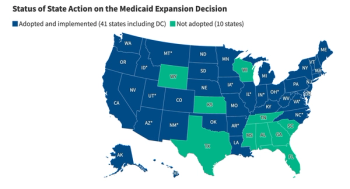
August DTR Analysis: HMO enrollment
August DTR Analysis.
HMOs continue to represent a cost-effective option for comprehensive medical and prescription drug coverage for patients, according to industry watchers.
“In the face of increasing healthcare costs and changing consumer preferences, we have seen managed care organizations continue to innovate with new healthcare insurance product offerings,” according to Brian J. Corvino, manager, strategic planning, PharmaStrat Inc., in Flemington, N.J.
“As new products emerge we anticipate a shift toward newer products such as Health Savings Accounts [HSAs], Consumer-Directed Health Plans, High-Deductible Health Plans [HDHPs] in the years ahead,” Corvino says. “In addition, we continue to see a long-term shift toward increased financial responsibility of the end consumer within the healthcare arena. Increasingly, consumers are being asked to bear more of the financial burden of their healthcare costs. As a result of increased financial responsibility, consumers have demanded enhanced flexibility and choice in their healthcare decision making. We anticipate this trend toward enhanced consumer choice to continue in the years ahead.”
California, New York and Pennsylvania, remain at the top of the list in regard to total HMO enrollment. “When looking at total enrollment figures we would expect these states to continue to be at the top of the list due in large part to the sheer population that exists in these states,” Corvino says. “Furthermore, these states have been at the forefront of managed care for years, and thus we see large overall HMO penetration rates in these populous states.”
In addition, California, New York and Pennsylvania, have high concentrations of Medicare beneficiaries that look toward Medicare Advantage plans, according to MHE Editorial Advisor Joel V. Brill, MD, chief medical officer of Predictive Health LLC. “These states have dominant Blue Cross Blue Shield plans that have encouraged participation in managed care HMO programs,” Dr. Brill says. “Kaiser Permanente also accounts for a large portion of the growth in California.”
What is most interesting to note, according to Corvino, is the sheer increase in HMO enrollment figures in California, in comparison with the rest of the states. “For the most part we continue to see an overall drop in overall HMO enrollment in most states,” he says. “This has not been the case in the California market.”
According to Corvino, this particular chart can be used to identify regional trends that might be occurring year after year. “It is very interesting to see the sheer overall numbers of HMO enrollment on a state-by-state basis,” he says. “Within the HMO space, there are significant regional differences that often impact HMO penetration rates by region. By reviewing state enrollment figures on a year-after-year basis, one has an opportunity to identify interregional trends and potential growth opportunities fairly quickly.”
A trend or just a blip?
For example, Corvino is interested in looking more into the chart data that reveal a general decline in HMO enrollment in most states, with the exception of California. “California is often a leader within the managed care arena and often is a high-profile example that is looked to by other states as a model. As overall enrollment in HMO products continue to decrease, I’d be interested to see similar data for other insurance products,” he says.
Dr. Brill believes that this enrollment decrease could be due to a number of reasons. “Patients are interested in plans that offer more choice and less restrictions, such as PPOs,” he says. “In addition, there are 1 million-plus individuals that already have enrolled in consumer-directed plans.
“I would not be surprised if there is a further downward trend in HMO enrollment for 2005,” Dr. Brill continues. “However, the healthcare trend has remained in double digits. With the MA-PD and PDP plans in 2006, increasing costs of specialty pharmaceuticals and medical devices, and CMS’ proposals to implement value-based purchasing/pay-for-performance as a mechanism for controlling costs, I would not be surprised if we see a swing back to increasing HMO enrollment by 2007.”
Newsletter
Get the latest industry news, event updates, and more from Managed healthcare Executive.





















































